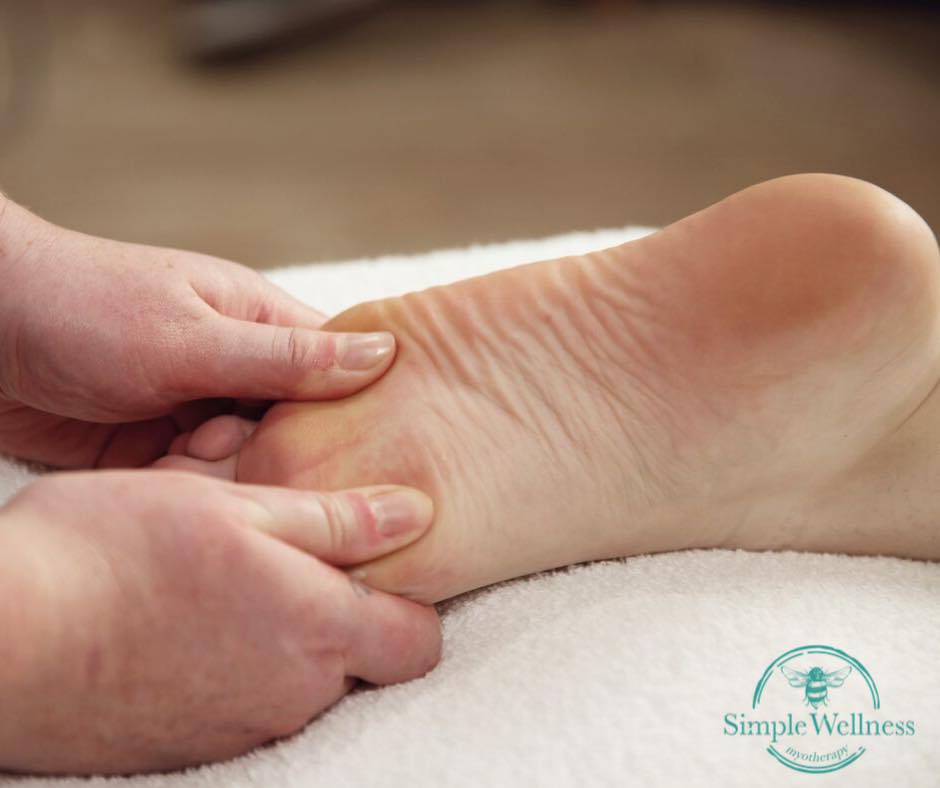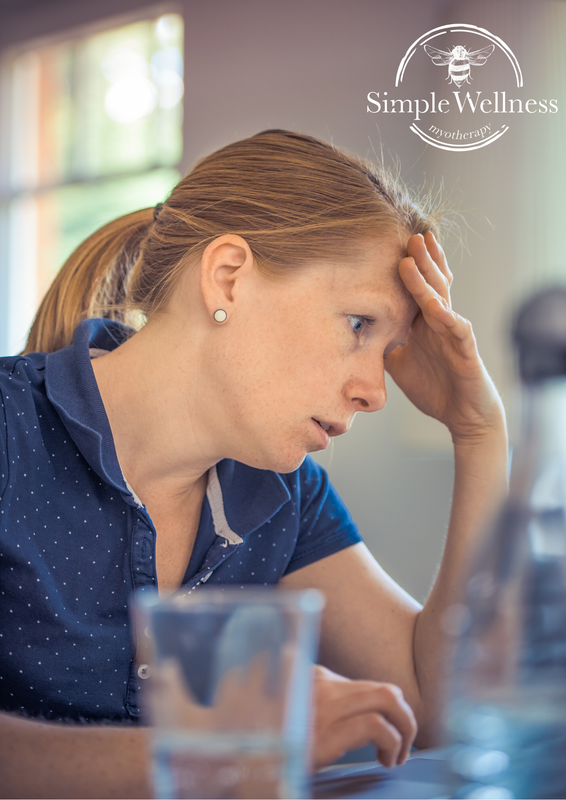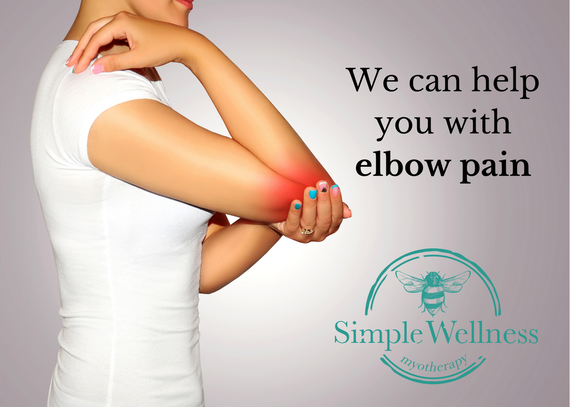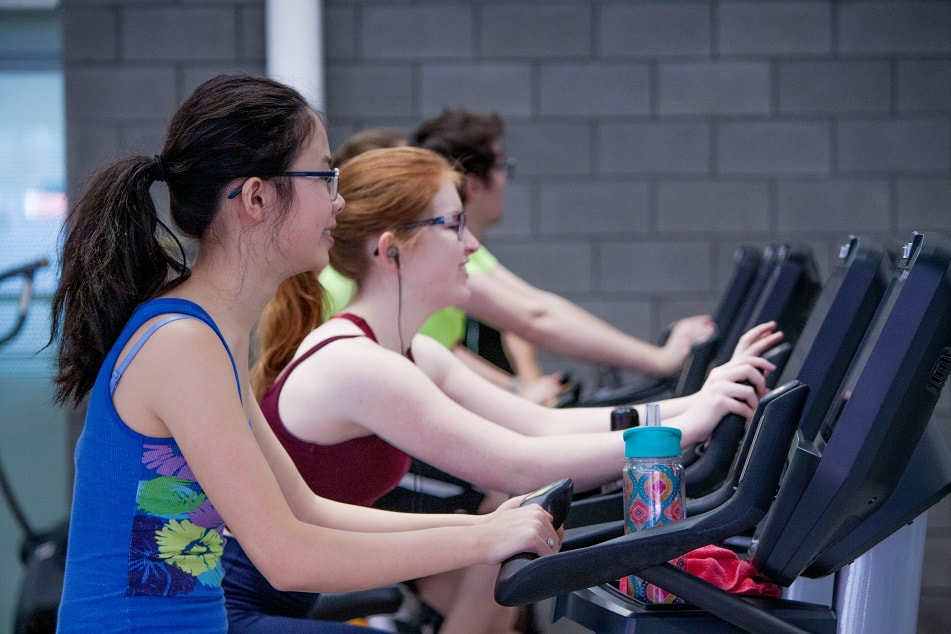|
Does this sound familiar? Terrible pain in your first few steps in the morning. Pain on standing up if you’ve been sitting for a little while. Putting weight on that foot can be agony. You feel it strongest in the heel or arch of your foot. Once you get moving it seems to calm down. If you're saying yes to these symptoms, you could be dealing with a condition called Plantar Fasciitis. Its quite common, and one of the most frequent foot pains that our myotherapists help people with. Plantar Fasciitis is a very painful condition that affects your heel and the sole of your foot. Often the mornings are the worst pain, people often explain they feel like they have to hobble about for the first few minutes of their day.
Usually it affects one foot or the other - some very unfortunate people can get both feet affected at the same time. Symptoms include heel pain; arch pain; altered walking patterns; cramps or spasms in the sole of the foot. Usually the pain reduces after getting moving, but those first few steps can be uncomfortable through to excruciatingly painful. What kinds of treatments work best for Plantar Fasciitis? The techniques I've found that work the best for people with Plantar Fasciitis are:
The hands on treatment sessions are only part of the recovery plan though. Like with most pains or injuries, looking at the way you move and stretch outside of your time in the clinic is important to helping you feel better, quicker. Our therapists will show you some simple but effective movements that help you to stretch your foot and leg to reduce the pain. We can also offer you some temporary pain relief suggestions like ice bottle rolling and using spiky physio balls. Ready to look at a plan for kicking Plantar Fasciitis? Book a 60 Minute Initial Consultation with us. We'll assess your movement and muscle balance, give you a feel-good hands on treatment, and walk you step by step through your treatment plan. Headaches are one of the most common issues our Myotherapists and Remedial Massage Therapists help people with. There are a bunch of variable ways that headaches can turn up - sometimes affecting only one side or the other; sometimes just the top, sides, or back of your head; sometimes very pinpoint spots like right behind your eyes; squeezing tension bands across your temples and eyebrows; starting from your jaw and spreading upwards; or just generally your entire head.
No matter which type you get, its never a good day if you need to persevere with a headache. There are a lot of factors that can influence headaches. Trigger points in your neck, shoulders and face can send some intense referred pain headaches, and these trigger points respond particularly well to hands on treatments like remedial massage, cupping and gentle mobilisations. Dehydration and exhaustion can be linked with headaches. If you suffer regularly, keep an eye out for your usual water intake and sleep patterns. By improving your quality of sleep and the amount of water your body has available to use, you may find your headaches reduce or go entirely! Stress and hormonal changes can also lead to headaches. Have you ever noticed how your neck, shoulders and face become much tighter when you're under stress? Do you clench your teeth, or hunch into a protective position? Some women find that they get a headache at specific times during their cycle due to changing hormone levels. Hormones are something that are outside of our scope as remedial massage and myotherapists, but many of our patients have found Acupuncture to be a useful tool in balancing hormones. Our good friend Amanda at Upwey Acupuncture can help you explore hormonal treatment options, including menstrual and menopausal symptoms. Eye strain can bring on headaches, as I found out last year! We got a new TV and I got intense tension band headaches every time I watched it for longer than about 10 minutes. My optometrist checked my vision and prescribed my glasses to help reduce the strain on my eyes, and it helped resolve my headaches! If you already wear glasses, is it time for a check up? If you don't wear glasses, perhaps an eye test could be helpful for you. Aside from taking over the counter medications like Panadol, how can you get help with easing and resolving a problematic headache? A great first step is to book with one of our therapists so we can assess your headaches and determine if they have a musculoskeletal origin. We can often help people get rid of their headache and set them up with a plan to prevent future headaches. A Short 40 Minute Initial Consultation is ideal for your first appointment to investigate your headaches. You’ve been told you have Tennis Elbow, but you don’t even play tennis? The pain can catch you off guard, and make normally simple tasks feel really difficult - opening jars, turning door handles, shaking someones hand, maintaining your grip on something. This type of pain can feel like a deep muscle aching, a stretch in the muscle, sharpness when you move, or a combination of these feelings. Our Myotherapists and Remedial Massage Therapists can help by creating a treatment plan for you that relieves the pain and gives you back your strength and ability to turn, twist and grip again.
Tennis Elbow is a painful condition of irritation and inflammation of the tendons around the outer side of your elbow. Its normal to feel the dull, constant ache throughout the day, and have the pain turn into sudden, sharp or shooting pain when you move your elbow or wrist, or try to grip something or twist a lid or door handle. It can happen if you spend a lot of time doing repetitive wrist movements like typing, using tools, carrying something heavy for a long period of time. We see it with people who play musical instruments too, or video gamers who get so into the game they forget to take a break for hours on end. Our typical treatments for this kind of pain will look at assessing your movement and strength first so we can plan out some short and long term goals. Our short term goals are usually the ones you want the most - to get rid of this awful pain!! But its also important to plan for the long term goals of recovering the strength in the area so that this feeling doesn't come back. A series of hands on treatments can help to reduce the pain and sensitivity in the area, and we'll give you a few movements that help that you can focus on between treatments. This is a pain that tends to respond well to doing some stretch and strengthening movements each day, starting with small easy movements, working up to more challenging or weight resisted ones. The hands on part of your treatment may include some remedial massage, cupping, active release techniques, dry needling, and trigger point therapy. Afterwards we can support your elbow with kinesiotaping to reduce pressure over the joint and tendons. Do you need help with elbow pain? Our therapists are ready to help assess your pain and work with you to create a treatment plan to reduce the irritation and restore your movement and strength. Book your first consultation with us now! Most people have heard of the Rotator Cuff being a big culprit of shoulder pain, but do you know what it is and how to get help? Our Myotherapists and Remedial Massage Therapists help a lot of people with Rotator Cuff pain - its one of our most commonly treated pains! The Rotator Cuff is a group of 4 muscles that all work together, and they have different actions. So when you come in with a Rotator Cuff injury, the first thing we’ll work out for you is which muscle is causing you to feel the pain.
The job of the Rotator Cuff group is to move and stabilise your shoulder, and it does that by making what I like to light heartedly call the Shoulderblade Sandwich. Imagine your shoulderblade bone (scapula) as the filling of the sandwich, and the Rotator Cuff muscles are the bread on either side. The muscles on the outer side work to lift your arm and rotate it outwards away from your body, and the inner muscles rotate your arm inwards. The most common issues we see with Rotator Cuff complaints is tight muscles referring pain, or muscle tears. Rotator Cuff referral pains can be felt locally around the shoulder, as well as further down your arm, elbow, wrist and hand. If you've got a Rotator Cuff tear or a partial Rotator Cuff tear, you'll likely notice pain and difficulty on raising or rotating your arm. Muscle tears can be identified on an ultrasound. If you’ve already had the ultrasound and been given the report that you have a tear, the next step for you is to rehabilitate that muscle, and we can help! Pain from shoulder and Rotator Cuff injuries usually respond well to hands on treatments like massage, cupping, or dry needling. We also like to help stabilise your shoulder using kinesiotaping. So how do you get help if you think you might have a Rotator Cuff problem? Firstly, book a time to come see us so we can help you find which of those 4 muscles is acting up. We’ll do some muscle testing and make a plan for reducing your pain and getting you strong again. If we think you may need an ultrasound to check for possible muscle tears, we can refer you to Dr Waj Dib here at Together Medical Family Practice in Knoxfield. Dr Dib is a fully bulk billed GP who can send you for scans if you need them. As we get into the swing of the new year, many people will make a resolution to get fit. But if you go about this the wrong way, it can end in an injury that puts you on the sidelines for weeks or even months.
Exercise is amazing for your body and your mind. It boosts mental wellbeing, helps you to manage pain and over the long-term can protect you against injury. So how can you get back into a fitness regime without hurting yourself? Here are our top tips to minimise your chance of injury. Start small – even if you used to be a master! We know from experience that it’s really tempting to go back to doing what you have done in the past. After all, running that fast, lifting those weights or doing Pilates 5 days a week used to be easy! But whether you’ve been away from exercise because of injury, pregnancy or just that life got on top of you, this is the most common mistake people make. Over time, your muscles will become less conditioned. If you go back to your old regime, it may be too stressful on your body and lead to an injury. So don’t just jump in where you were. Instead, go back to the start. Your body will start to remember if you give it time to warm back up to exercise. Increase your frequency and intensity with time This goes hand in hand with the first point. It takes time for the body to get back into the swing of things. So give yourself at least a couple of months to get back to where you were before you stopped. For example, let’s say you used to run 10km 5 times per week. You’ve just had a break for several months due to a new job that took up your time. To get back into it, you might want to pace yourself by doing: 2km gentle jog x 2 for the first week to assess your fitness 5km gentle jog x 2 for 2 weeks 5km run x 3 for 2 weeks 7.5km run x 3 for 2 weeks 7.5km run x 4 for 2 weeks 10km run x 3 for 2 weeks If you’re feeling good and have had no injuries or flare-ups, then progress back to your 5 x 10km runs. As you can see, this progression takes 10-12 weeks to get back to your original program. It may take longer if you’ve been off exercise for a longer period of time or had a significant injury. But it will pay off in the long run if you pace yourself! Make sure you’re getting good nutrition and plenty of sleep Exercise recovery starts from the moment you stop exercising. There are a lot of factors that contribute to recovery, but nutrition and sleep are two of the most important. Our bodies use nutrients to heal and grow muscles, and most of this healing takes place as we sleep. For nutrition, our nutritionist buddy Samantha Gemmell recommends eating plenty of wholefoods for a good mix of protein, vitamins, minerals and antioxidants that support recovery. When it comes to sleep, Sam says that quality is just as important as quantity. Make sure that your room is completely dark, avoid caffeine after 3pm and minimise your screen time for 30 minutes before bedtime. Do some gentle stretches after your workout Exercise is great for your body, but it can lead to muscle tension. Muscle tension can put you at risk of injury. So how do you minimise that risk? One way is to stretch out after a workout. This doesn’t have to be anything too extensive. If you’ve gone for a run, do some gentle stretching of your legs and hips. If it’s upper body day at the gym, stretch out your shoulders and upper back. 1-2 minutes of stretching after each workout can add up! Give your body some TLC Sometimes stretching isn’t enough, and your muscles need a little extra TLC. Many people will get a relaxation massage or remedial massage, but this only addresses one aspect of the muscle tension. That’s where myotherapy comes in. Myotherapy incorporates massage with other techniques such as dry cupping, needling, trigger point therapy and taping. This combination can be helpful for not only treating exercise-related injury but also preventing it. Your myotherapist can also assess your muscles and joints to see if any are at significant risk of injury and prescribe exercises to strengthen those areas. Want to show your body that TLC and reduce your risk of injury? Book in with one of our friendly myotherapists here. |
Meet Our Team
We have a team of great practitioners available 7 days a week at our Rowville clinic. Archives
July 2024
Categories
All
|
Got a question about Myotherapy?
Contact Mel by phone, email or Facebook
|
Simple Wellness Myotherapy & Remedial Massage Clinic
Shop 12B 150 Kelletts Rd Rowville VIC 3178 |
Phone us on
03 8204 0970 |






 RSS Feed
RSS Feed